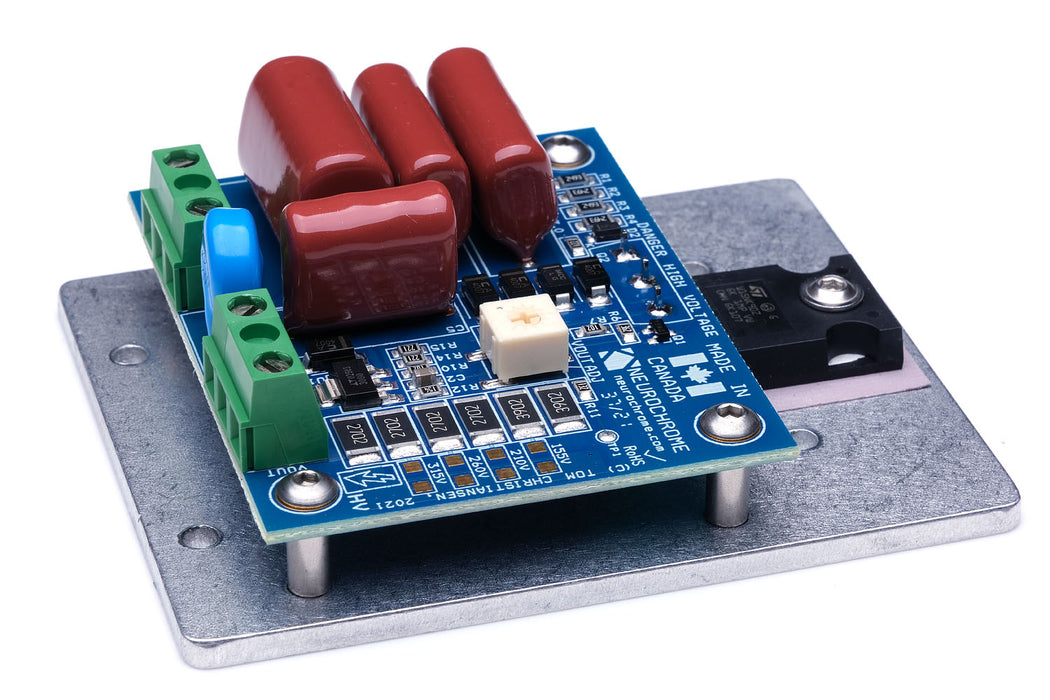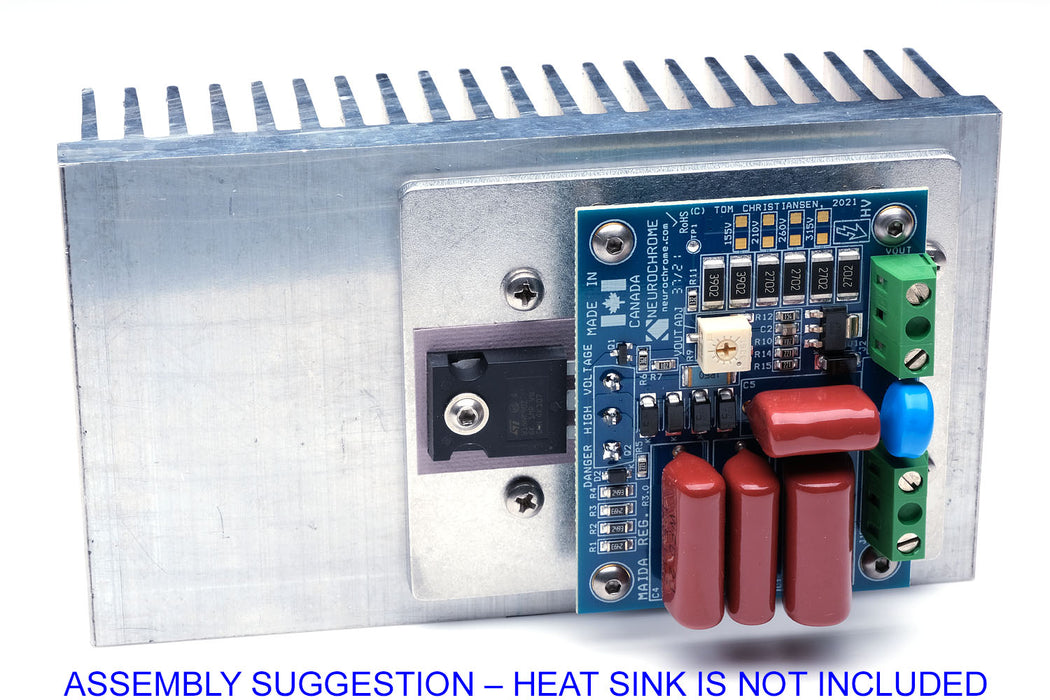-
WARNING: This voltage regulator deals with high voltages — LETHAL voltages. If you are not comfortable or qualified to deal with these potentially deadly voltages, please do not attempt to use this circuit. Proceed at your own risk, expense, and responsibility.
The Regulator can provide any output voltage from 155 V to 495 V in five ranges as shown below. Within each range the output voltage is adjusted by a trimpot offering an adjustment range of approximately ±15 %.

Output voltages below 155 V can be obtained by adding a power resistor external to the module.
Regulator Impact on Sound Quality
When used in tube amplifiers, single-ended and push-pull designs alike, the 21st Century Maida Regulator results in marked improvements in sound quality. Most commonly builders report:
- Zero hum.
- Much bigger sound stage.
- Firmer and punchier bass.
- Open and natural midrange.
- Clearer and more precise treble.
These properties are the direct result of the low output impedance, low noise, and phenomenal ripple rejection offered by the 21st Century Maida Regulator. The 21st Century Maida Regulator is also being employed in commercial builds with stellar results. For example, you can read Don Sachs' impressions of the regulator here: Don Sachs Consulting - Custom KT88 Amplifier.
The input to the 21st Century Maida Regulator should be a rectified DC voltage. The input voltage should be at least 15 V higher than the output voltage at all times, including at the bottom of the ripple valleys.
The 21st Century Maida Regulator is compatible with both tube and silicon rectifiers and requires only a small reservoir/smoothing capacitor in the power supply. The extraordinary ripple rejection is shown in the oscilloscope screen shot below.

In the above measurement, the input voltage was a full-wave rectified sine wave with a 100 µF reservoir capacitor. The load current was 200 mA. The resulting ripple voltage on the reservoir capacitor is clearly evident above and measures about 14 Vpp. The output voltage is completely free of ripple or hum - even at the highest resolution of the oscilloscope (2 mV/div). The measurement bandwidth for above measurement was 20 MHz.
-
The 21st Century Maida Regulator offers the following features:
- Fully assembled module! All you need to add is a heat sink.
- True floating regulator design.
- Ultra-low output impedance.
- 2 µV RMS noise within the audio band.
- 130 dB ripple rejection (120 Hz).
- Five overlapping voltage ranges allows for the selection of any output voltage in the range of 155 V to 495 V. The range is selected by a wire link.
- A trimpot offers ±15 % adjustment of the output voltage within each range.
- Soft start.
- Capable of start-up into a purely capacitive load (up to 47 µF verified).
- Start-up into harsh load (2.2 A inrush light bulb load).
- Handles high di/dt current pulses such as the ones caused by loose connections in tube sockets.
- Input voltage transient suppressor.
- Compact 83 × 66 × 28 mm form factor.
- RoHS compatible, gold plated circuit board.
The 21st Century Maida Regulator Rev. 3.0 is designed, manufactured, and assembled in Canada.

Revision 3.0 features many improvements over the previous versions, including:
- Input transient suppressor.
- Protection against glitches in output current.
- Softer start-up.
- Better protection of the regulator IC.
- Cascode MOSFET rated for 350 W of pulse power.
- Circuit board further optimized for high-voltage operation.
-
The specifications for the 21st Century Maida Regulator Rev. 3.0 are tabulated below.
| Parameter |
Value |
Notes |
| Absolute Max. Input Voltage |
630 V |
|
| Max. Output Voltage |
495 V |
|
| Max. Output Current |
400 mA |
|
| Output Impedance |
< 10 mΩ |
1 kHz, Vout = 400 V |
| Residual Noise and Hum |
2 µV RMS |
Vout = 400 V, BW = 20 kHz |
| Output Voltage Trimpot Adjustment Range |
±15 % |
|
| Start-Up Time |
10 s |
95 % of Vout
|
| Drop-Out Voltage |
15 V |
|
| Regulator Supply Current |
2.0 mA |
|
| Minimum Load Current |
0 mA |
|
| Dimensions & weight |
83 × 66 × 30 mm
85 g
|
|
-
The first three performance graphs below are based on circuit simulation. This is due to the simple fact that the regulator outperforms my measurement equipment. Of these three parameters, the only parameter that I was able to verify by measurement is the output noise, which measures 2.0 µV RMS within the audio band. Even that pushed the limits of my 6.5-digit bench top DMM.
The output noise of the 21st Century Maida Regulator is shown below. Lab measurements confirm an output noise voltage of 2.0 µV within the audio band. With the 10 Hz – 10 MHz band shown below, the total RMS noise is 5.6 µV.

The line rejection of the 21st Century Maida Regulator Rev. 3.0 is shown below. The line rejection describes how well the regulator handles perturbations on the input voltage, such as ripple voltage. As seen below, the ripple rejection is nearly 130 dB at 120 Hz.

The graph below shows the output impedance of the regulator. Note that this does not account for the impedance of PCB traces and connectors. That said, it is exceptionally low and I am comfortable specifying an output impedance below 10 mΩ at 1 kHz for the regulator.

The 21st Century Maida Regulator features a soft start. As shown below the regulator starts up in approximately ten seconds. It settles fully within a minute or two.

-
The 21st Century Maida Regulator needs to be mounted on a heat sink. To make life easier for the builders, I provide the drill template below.
21st Century Maida Regulator Rev. 3.0 Drill Template: MaidaReg_R3p0_DrillTemplate.pdf









